The Research
Current numbers of deeper burrowing earthworms in many arable soils are suspected to be below historic levels. This is thought to be due to intensive cultivation, the use of artificial fertilisers, lower applications of organic matter and a reduction in rotations that include livestock grazing. As a result, the level of organic matter has been falling in the soil and depriving earthworms of their food source.
There is currently little UK-based quantitative data on the impact of cultivation practices and organic matter additions on earthworm numbers and crop rooting.
In this field lab, farmers researched whether sustainable soil management practices – like minimum tillage and organic matter application – can increase crop rooting and yield by boosting deeper-burrowing earthworm populations.
During a previous trial, the group of four farmers found that worm counts thrived with farmyard manure applications and shallow or no cultivation. This field lab built on that previous trial and hopes to strengthen the case for practices which increase earthworm populations.
The Benefits
- Limited rooting depth is suspected to be a major limitation to cereal crop yields, as many crops have shallow roots that can’t fully access water and nutrients below 40cm depth
- Deeper burrowing earthworms provide multiple benefits to crops; they can aid water infiltration, help prevent waterlogging, and break up soil below the level that everyday machinery can access.
- This allows crop roots to take hold and access previously unavailable nutrients and moisture.
Trial design
Each farmer picked soil management practices that were relevant to their farming system, such as deep cultivation, strip till, direct drilling, but always included with or without farmyard manure. They set up different tramline trials, with some replicating these, in order to test the impact of these different soil management practices. All the farmers grew winter oilseed rape for the trial.
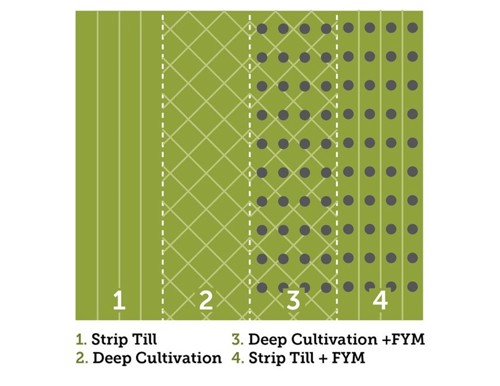
Measurements:
- Counts of earthworms and middens - small accumulations of digested/plant material above the burrow of a deep-burrowing earthworm
- Visual evaluations of topsoil and subsoil structure
- Yield map data
- Visual assessments of rooting in 1 metre deep soil pits
Visually assessing earthworm and midden counts
August 2020: Soil Pits
Method:
In August the three farmers taking part in the deep rooting field lab, dug soil pits to a depth of > 1m in their trial plot areas. This allowed them to visually assess the following:
- Crop rooting depth
- Number of anecic (deep burrowing) earthworm burrows
- Evidence of crop roots utilising burrows
- Differences in the soil appearance and structure of soil layers
Example, Rory Lay, Shropshire.
Rory’s trial field is a sandy clay loam and he has grown winter oilseed rape in the trial field this year. This is the second year that the treatments have been established.
Rory Lay was comparing the following treatments:
- Strip till plus FYM
- Strip till
- Deep cultivation, plus FYM
- Deep cultivation
*FarmYard Manure
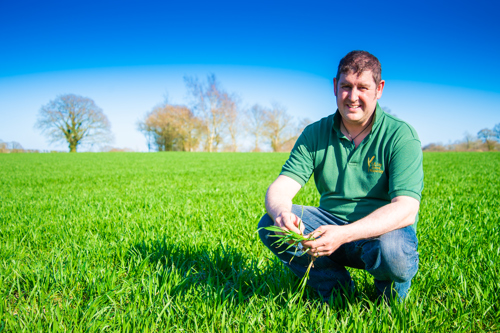
Rory Lay
Rory’s farm standard management is deep cultivation however he wanted to test whether strip tillage which is less disruptive to soil structure would help to increase earthworm numbers. It was hypothesised that the Strip till plus FYM treatment would support the highest number of deep burrowing earthworms as this management would provide a food source (the FYM) whilst also not disturbing the soil and existing burrows (unlike the deep cultivation treatments).
Spring assessments provided evidence that there were more deep burrowing earthworms in the strip till plus FYM treatment.
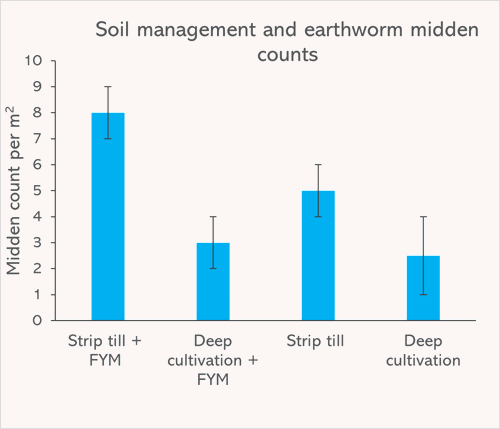
Number of anecic earthworm middens counted during spring assessments comparing four soil management treatments.
Middens
Middens are deposits of earthworm casts (material which as passed through the earthworm gut) mixed with decaying plant material and are found on the soil surface at the entrance to anecic earthworm burrows. Middens are therefore a good indicator of the number of anecic earthworms in the soil.
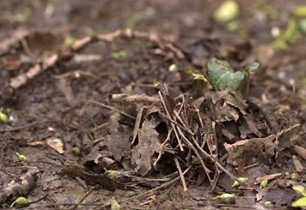
Soil pit results:
Rory dug his soil pits on 8th August. He found evidence that the oilseed rape crop roots were utilising earthworm burrows in all four of his trial treatments (see below photos). This supports the key idea behind this field lab which is that crop roots grow to depth down earthworm burrows. There was evidence of this happening at >90 cm depth.
Have a look at Rory's films on YouTube by clicking on the links below:
Rory's video describing his results from deep cultivation and farm yard manure.
Rory's video showing results from min till and no farm yard manure.
Earthworms
Rory noted that earthworms were abundant in all the treatments but that there were noticeably more in the treatments which had received farmyard manure. This is again what was predicted as the manure provides a food source for the earthworms.
The deep cultivation treatments were cultivated in the autumn of 2018 (2 years ago when the trial was established) perhaps allowing for some earthworm recovery over this period.
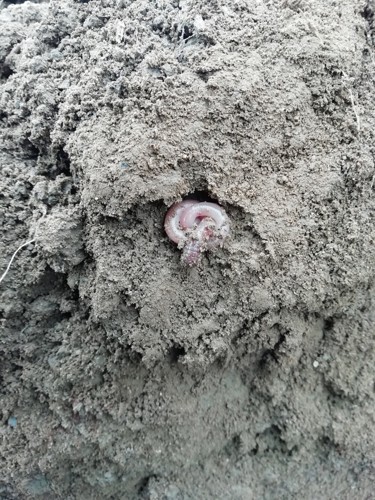
Key conclusions from soil pits
- Earthworms particularly abundant in plots with FYM addition – this is expected as provides a food source.
- Many observations of OSR roots growing down old earthworm burrows
Next steps:
The next step will be to compare how crops have performed between the trial treatment areas using ADAS’s agronomics methodology which tests for statistical significance in yield between trial areas taking into account the underlying environmental variation within the field. This will be a robust test of whether there are statistically significant differences in yield between the trial plots. The group is particularly interested in investigating whether improvements in crop rooting depth due to roots utilising deep burrowing earthworm burrows, has allowed greater access to water and nutrients thus positively effecting yield.
Final report - summary of results
The full final report, including details on the individual trials, can be found in the results and reports tab of the field lab page.
Summary of findings:
- Soil organic matter was notably high for plots with added manure. Soil structure (assessed visually) was very similar across treatments, however differences would only be expected to show after several years.
- Earthworms were particularly abundant in plots which were treated with farmyard manure additions. This is because added farmyard manure provides a food source for the earthworms.
- Visual assessments showed a lot of evidence of oilseed roots growing down earthworm channels, up to depths of 90cm.
- The group is interested in doing further research to see if deeper crop rooting from utilising earthworm burrows has allowed more access to water and nutrients, thus positively impacting yields.
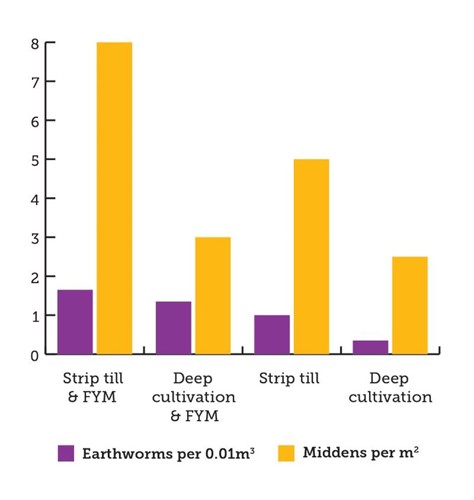
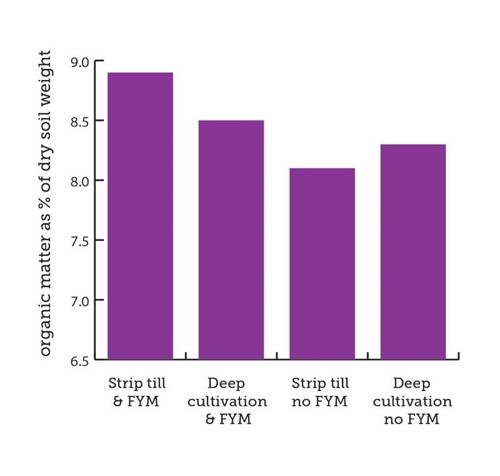
Harvest yield results
Initial yield results from the three farms do not indicate a notable impact on yield from the different treatments. The researcher explained that this is not surprising, as we would expect any increases in anecic (deep-burrowing) earthworm populations to take place slowly, so only after several years would the effects on rooting, yields and soils be apparent.
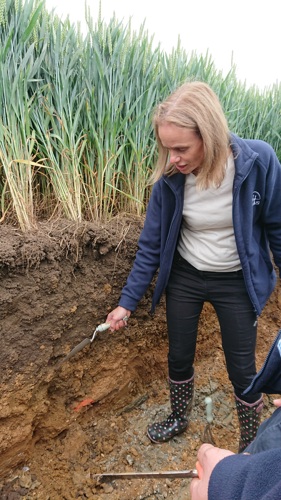
Farmer films showing soil pits
Triallist Rory Lay has made two short films for the programme showing the soil pits which were dug on different plots, and explaining the findings. Click on the links below to view them.
Rory's film showing results from deep cultivation and farm yard manure.
Rory's film showing results from min till and no farm yard manure.
On-farm assessmens
March 2020
On-farm assessments
June 2020
Group meeting & results discussion from spring assessments
June 2020
Harvest Assessments
August 2020
Data Analysis
September 2020
Results Meeting
November 2020
Final report published
December 2020
Group Coordinator

Despina Berdeni
ADAS
Liverpool
Despina is a Soil and Crop Research Scientist at ADAS. Her research has focused upon the interaction between soil biological communities, soil health and plant physiology within sustainable agroecosystems. She previously worked as a Research Associate in plant-soil interactions at the University of Sheffield after completing a PhD in 2017, where she used molecular ecological methods to investigate the interaction between soil microbial communities, soil management and crop performance.
Researchers

ADAS
ADAS
Liverpool
In this section you will find reports and results from the field lab, as well as other relevant documents.